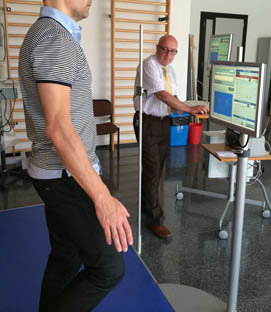
The research group Intelligent Data Analysis Laboratory (IDAL) of the Department of Electronic Engineering of the School of Engineering (ETSE) of the UV and a team of scientists of the Faculty of Physiotherapy led by Professor Felipe Querol have set up an innovative project for monitoring people with Haemophilia’s physical activity through individual devices with the purpose of developing patterns which help to improve the quality of life and treatment of these sick people.
The research, in which 12 scientists will participate for two years, is funded by the pharmaceutical company Baxter, worldwide leader in therapies related to Haemophilia, with the collaboration of the company Analog Devices, which has provided the project with accelerometers and modules that patients will wear to capture the information; and with La Fe Hospital.
This project consists on the incorporation of some small devices called accelerometers to people suffering from Haemophilia, concretely to a total of 20 sick people, and a group of healthy people for two years. The accelerometers are placed in the wrist or in the clothes, with the purpose of registering pure signals (during daily life activities) which then, in the laboratory, “we can decipher and correlate with other studies, as thematic images of the joints, ultrasound imaging data, bioelectrical impedance, densitometry and variable forces, joint gestures and laboratory values, which enable us to know the plasma levels both of clotting factors and other parameters influencing people's health”, explains ETSE-UV researcher Emilio Soria.
The objective of this work is elaborating knowledge patters and thus being able to monitoring physical activity of patients suffering from Haemophilia their impact in physical condition and their relation to the chronic Haemophilic and the comorbidity derived from the current life expectancy”, points out doctor Felipe Querol, Tenured Professor of the Department of Physiotherapy of the UV and associate doctor of La Fe Hospital.
To monitor the degree of fulfilment of the activity and its reflection on the improvement of the patients, this research “is going to have a direct impact on the health system, since Haemophilia constitute one of the most difficult diseases to treat and more expensive from the Health System”, adds Querol, who recalls that reducing the influence on patients suffering from this disease can, in first place, improve their life quality and, in second place, “reduce the associated healthcare costs. These patients’ quality of life have improved in the last years thanks to the advances in new medicines and therapies but, what has been proved, is that this quality depends directly on the physical activity they carry out” he concludes.
Individualised microeletronic devices
As a technologic innovation in this project, stands out the participation of the multinational leader in the fabrication of microelectronic devices Analog Devices (ADI), with headquarters in Valencia. Its implication consists on providing state-of-the-art accelerators as well as supporting the development of the specific acquisition system for this application. These devices will enable the development of new algorithms to determine the kind of physic activity in development (walking, climbing stairs, etc.)
The accelerometers, sensors and ADI processers enable acquiring signals with high resolution, reliability and very low consumption which make them very suitable for portable medical systems. Concretely, as ETSE-UV professor and responsible for the Design Centre of Analog Devices in Valencia, Javier Calpe, indicates “the ADXL384 is a very low composition and great accessibility triaxial accelerometer”. ADI has as main objective to develop integrated circuits for applications in the field of health both for diagnosis equipment and for customised monitoring.
Specific research line
The Faculty of Physiotherapy of the UV has a research line open in Haemophilia and pays special attention to degree and postgraduate training of this pathology whose study provides, apart from facilitating the care of these patients, interesting advances in other extremely frequent pathologies such as arthrosis. The Department of Physiotherapy collaborates directly with the Haemostasis and Thrombosis Unit of the Polytechnic and University Hospital La Fe, which is a referent in this pathology and a worldwide reputation training centre by the World Federation of Haemophilia. Foreign professionals systematically attend to be trained in the diagnostic and treatment of this disease.
The Haemophilia is a congenic disease, linked to the X chromosome, which is transmitted by women but suffered by men, and in which, as a consequence of a deficit of coagulation factors, Haemorrhages are produced, which can only be stopped by the administration of the creating factor. It is a rare disease, suffered only by 1-2 people out of 10.000 born alive and can appear without familiar antecedents as a consequence of genetic mutations.
The most frequent Haemorrhages are in joints, and when it occurs in people who are not under the suitable treatment, provoke, from a really early stage of life, a degenerative process known as Haemophilic Arthropathy. The 80% of the world population has not access to the hematologic treatment and their life expectation is, apart from being short, implies a physical disability. “To graphically express the joint problem, the knee of a 9 year old child may seem the knee of an arthritic 80 year old man and, disappointingly, this problem still exists”, explains Felipe Querol.
This project is framed within what is known as ‘Internet of Everything’; everything is currently interconnected, which enables extracting knowledge (in this case degree of fulfilment of the exercises) of the unprecedented amount of information available through different devices, in this case it is known as devices for wearing (wearables).
Last update: 26 de november de 2014 11:30.
News release



















